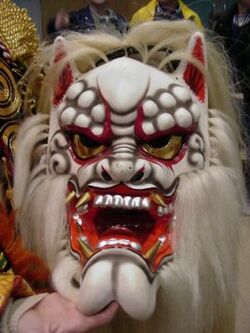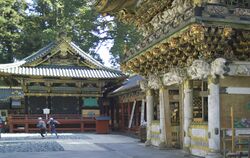Kagura
Topic: Religion
 From HandWiki - Reading time: 4 min
From HandWiki - Reading time: 4 min
Kagura (神楽, かぐら, "god-entertainment") is a Japanese word referring to a specific type of Shinto theatrical dance—with roots arguably predating those of Noh. Once strictly a ceremonial art derived from kami'gakari (神懸, かみがかり, "oracular divinaification"), Kagura has evolved in many directions over the span of more than a millennium. Today it is very much a living tradition, with rituals tied to the rhythms of the agricultural calendar, as well as vibrant Kabuki-esque theatre, thriving primarily in parts of Shimane prefecture, and urban centers such as Hiroshima.[1]
History
The epics Kojiki and Nihonshoki describe a folklore origin for the dances. In these texts, there is a famous legendary tale about the sun goddess Amaterasu, who retreated into a cave, bringing darkness and cold to the world. Ame-no-Uzume, kami/goddess of the dawn and of revelry, led the other gods in a wild dance, and persuaded Amaterasu to emerge to see what the ruckus was all about.[2] Kagura is one of a number of rituals and arts said to derive from this event.
Originally called kamukura or kamikura (神座), kagura began as sacred dances performed at the Imperial court by shrine maidens (miko) who were supposedly descendants of Ame-no-Uzume. Over time, however, these mikagura (御神楽), performed within the sacred and private precincts of the Imperial courts, inspired popular ritual dances, called satokagura (里神楽), which, being popular forms, practiced in villages all around the country, were adapted into various other folk traditions and developed into a number of different forms. Among these are miko kagura, shishi kagura, and Ise-style and Izumo-style kagura dances. Many more variations have developed over the centuries, including some which are fairly new, and most of which have become highly secularized folk traditions.
Kagura, in particular those forms that involve storytelling or reenactment of fables, is also one of the primary influences on the Noh theatre.
Imperial Kagura
The formal ritual dances (mikagura) were performed in a number of sacred places and on a number of special occasions. At the Imperial Sanctuary, where the Sacred Mirror was kept, they were performed as part of gagaku court music. Mikagura were also performed at the Imperial harvest festival and at major shrines such as Ise, Kamo, and Iwashimizu Hachiman-gū. Since around the year 1000, these events have taken place every year.
According to the ritual department of the Imperial Household Agency, kagura still take place every December in the Imperial Sanctuary and at the Imperial harvest festival ceremonies.
Folk Kagura
Satokagura, or "normal kagura", is a wide umbrella term containing a great diversity of folk dances derived from mikagura, and incorporated with other folk traditions. For the sake of brevity, a selection of traditions from the Kantō region will be used as examples.
- Miko kagura – dances performed by shrine maidens (miko) originally derived from ritual dances in which the miko channeled the kami, speaking, singing, and dancing as the god. Though these originally had a very loose form, akin to similar god-possession dances and rituals in other world cultures, they have developed, like many other Japanese arts, into highly regular set forms. Today, they are performed largely in worship to kami at Shinto shrines, or as part of a ritual martial arts demonstration at Buddhist temples. These dances are often performed with ritual props, such as bells, bamboo canes, sprigs of sakaki, or paper streamers.
- Izumo-ryū kagura – Dances based on those performed at Izumo Shrine serve a number of purposes, including ritual purification, celebration of auspicious days, and the reenactment of folktales. Originally quite popular in the Chūgoku region, near Izumo, these dances have spread across the country, and have developed over the centuries, becoming more secular folk entertainment and less formal religious ritual.
- Ise-ryū kagura – A form of dances derived from those performed alongside yudate (boiling water) rituals at the outer shrines of Ise Shrine. Largely associated with Hanamatsuri (April 8), the miko or other group leaders immerse certain objects in boiling water as part of a purification ritual. As with other forms of kagura, this has become secularized and popularized as it transformed into a folk practice.
- Shishi kagura – A form of lion dance, in which a group of dancers take on the role of the shishi lion and parade around the town. The lion mask and costume is seen as, in some ways, embodying the spirit of the lion, and this is a form of folk worship and ritual, as other forms of lion dances are in Japan and elsewhere...
- Daikagura – A form of dance deriving from rituals performed by traveling priests from Atsuta and Ise Shrines, who would travel to villages, crossroads, and other locations to help the locals by driving away evil spirits. Acrobatic feats and lion dances played a major role in these rituals.
Around the time of the beginning of the Tokugawa shogunate (1603-1868), performances derived from this emerged in Edo as a major form of entertainment. In connection with the celebrations surrounding the beginning of the shogunate, lion dances, acrobatics, juggling, and a great variety of other entertainments were performed on stages across the city, all nominally under the auspices of "daikagura". Over the course of the period, these came to be more closely associated with rakugo storytelling and other forms of populair entertainment, and still today, daikagura continues to be performed and include many elements of street entertainment.
References
- ↑ Petersen, David. (2007). Invitation to Kagura: Hidden Gem of the Traditional Japanese Performing Arts. Morrisville: Lulu Press.
- ↑ Nihongi: Chronicles of Japan from the Earliest Times to A.D. 697, translated from the original Chinese and Japanese by William George Aston. Book I, part 1, page 44f. Tuttle Publishing. Tra edition (July 2005). First edition published 1972. ISBN:978-0-8048-3674-6
- Derived primarily from the Japanese Wikipedia article.
- Giolai Andrea, Introducing Mikagura.Some Ethnomusicological Features of an Ancient Japanese Ritual, http://www.centrostudiorientaliroma.net/introducing-mikagura-%E5%BE%A1%E7%A5%9E%E6%A5%BD-some-ethnomusicological-features-of-an-ancient-japanese-ritual/?lang=en
External links
 KSF
KSF


